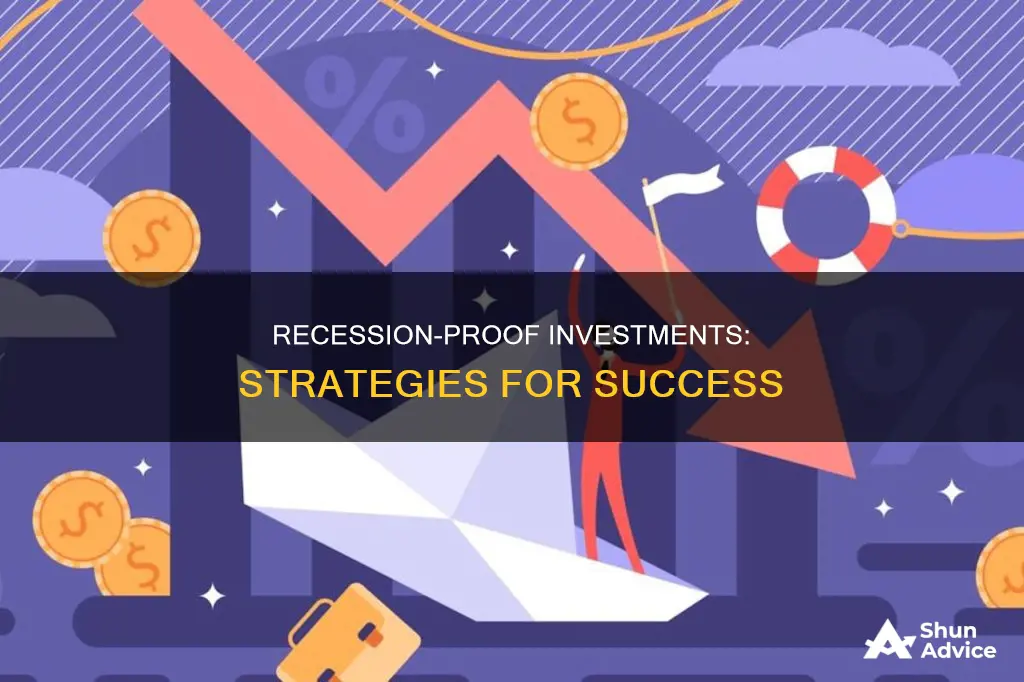
Investing during a recession can be daunting, but there are strategies to help you navigate the turbulent economic climate. Here are some key considerations to help you invest right before a recession:
- Maintain a long-term perspective: It's important not to make impulsive decisions based on short-term market fluctuations. Remember that recessions don't last forever, and historically, investors who hold on to their investments throughout these periods see their portfolios recover.
- Diversify your portfolio: Diversification is a crucial strategy at any time, but especially before a recession. Spread your investments across different asset classes, sectors, and industries to reduce risk.
- Focus on defensive sectors: Some sectors tend to be more resilient during a recession. Consider investing in consumer staples, healthcare, utilities, and other essential goods and services that people will continue to need regardless of the economic climate.
- Look for quality investments: Seek out companies with strong balance sheets, low debt, positive cash flow, and stable business models. These companies are more likely to weather the recession and offer stable returns.
- Consider fixed-income and dividend-yielding investments: Dividend-paying stocks and bonds can provide a steady income stream during a recession. They also offer the benefit of reinvesting dividends to lower volatility and potentially enhance returns.
- Avoid speculative and highly leveraged investments: Stay away from speculative stocks, as they tend to be the worst performers during a recession. Highly leveraged companies with high debt loads are also riskier investments as they may struggle to manage their debt payments.
- Don't try to time the market: Trying to predict the exact bottom of the market is challenging, if not impossible. Instead, focus on finding quality investments that you can hold for the long term.
- Build an emergency fund: Ensure you have adequate cash reserves to cover your living expenses for at least three to six months. This will provide a safety net and give you more flexibility in your investment decisions.
| Characteristics | Values |
|---|---|
| Investment type | Bonds, cash, dividend stocks, defensive stocks, utilities, consumer staples, healthcare, low-risk funds, high-quality assets |
| Investment strategy | Diversification, buying the dip, dollar-cost averaging, long-term investing |
| Risk management | Avoid growth stocks, speculative stocks, highly leveraged companies, cyclical stocks |
What You'll Learn

Think before you rebalance your portfolio
Rebalancing your portfolio is an important step in maintaining a balanced portfolio over time. It involves buying and selling investments to restore your original asset allocation, or mix of stocks, bonds, and other investments. While rebalancing is generally a good idea, there are a few things to consider before making any changes.
Timing is Key
Rebalancing during a market sell-off or when things are looking bleak can be detrimental to your portfolio. Selling during market lows can lock in losses, so it is often better to hold on to your investments until the market evens out.
Emotions and Risk Tolerance
It is important to consider your emotions and risk tolerance when rebalancing. Knowing how you have reacted to past market fluctuations should be a factor in how you allocate your investments going forward. If you pulled your money out of the market during a downturn, you may want to rebalance into a more conservative portfolio to weather future market drops with less stress.
Robo-Advisors and Professional Help
If you are unsure about how your portfolio should be invested or how to rebalance, consider using a robo-advisor. These digital investment management services can help you determine your risk tolerance and select and manage your investments. Alternatively, you can hire a fee-only fiduciary, who will have no conflicts of interest and will be paid for their time and advice.
Frequency of Rebalancing
There is no one-size-fits-all approach to how often you should rebalance your portfolio. Some people choose to rebalance at specific time intervals, such as once a year, while others only rebalance when their portfolio becomes clearly unbalanced. It is important to find a strategy that works for you and helps you maintain your desired level of risk.
Methods of Rebalancing
There are a few different ways to rebalance your portfolio. One method is to sell high-performing investments and buy lower-performing ones to achieve your desired asset allocation. Another option is to allocate new money strategically by investing in other stocks until your portfolio is balanced again. This second option allows you to leave your winning investments alone, hopefully allowing them to continue to outperform.
Madoff Victims: A Global Reach
You may want to see also

Consider buying the dip
"Buy the dip" is an investment strategy that involves purchasing stocks at a discounted price during a market decline, with the expectation that prices will recover in the future. This strategy is based on the principle of "buy low, sell high", allowing investors to buy stocks at a lower price in hopes of profiting when the market rebounds.
- Understanding the risks and limitations: Buying the dip does not guarantee profits, and there is a chance that stock prices could continue to fall. It can be challenging to distinguish between a temporary price drop and a signal of further declines. Additionally, attempting to buy at the lowest point is a form of market timing, which even seasoned investors struggle with.
- Evaluating the situation: Before buying the dip, it's important to assess the reasons for the price decline. While a temporary drop can present a good buying opportunity, there could be underlying issues that caused the decline, such as changes in earnings, poor growth prospects, or economic conditions.
- Setting a risk management strategy: When buying the dip, it's crucial to establish a risk management strategy to control potential losses. For example, setting a stop-loss order can help limit losses if the stock continues to fall.
- Focusing on sectors and large companies: During a market decline, consider looking at sectors that have been hit hard and large companies with stable track records that have experienced significant drops due to external factors.
- Dollar-cost averaging: Instead of investing a lump sum, consider using a dollar-cost averaging strategy by investing smaller amounts at regular intervals. This approach helps to reduce the impact of market volatility and can be particularly effective with 401(k) contributions.
- Building a diversified portfolio: While buying the dip can be a strategy for individual stocks, it's important to maintain a diversified portfolio that includes a mix of stocks, funds, and other assets. This diversification can help reduce the overall risk of your portfolio.
- Having cash reserves: Buying the dip requires having cash reserves ready to deploy at short notice. This strategy may cause you to miss out on other investment opportunities during rising markets, as the cash reserves typically produce little or no return.
- Setting clear goals: Consider your investment goals and risk tolerance before buying the dip. This strategy may be suitable for long-term investors who are comfortable with market volatility and have the financial stability to withstand potential losses.
February: A Month for Investing?
You may want to see also

Remember why you chose your investments
When the markets are volatile, it's important to remember why you chose your investments in the first place. This is a good time to review your portfolio and ensure that it remains aligned with your long-term goals.
Know Your Risk Tolerance
Understanding your risk tolerance is crucial when choosing investments. If you're comfortable with higher risk in pursuit of aggressive long-term growth, stocks are a good option. If you prefer lower-risk investments that let you sleep at night, consider bonds or cash.
Diversification is Key
Diversifying your investments across different asset classes, sectors, and geographic locations can reduce your risk. This way, if one investment performs poorly, the strong performance of others can offset the losses. Diversification can also increase your overall returns.
Long-Term Perspective
Give your investments time to grow and compound. A long-term investment horizon increases the likelihood of weathering market downturns and taking advantage of compounding growth.
Fundamental Analysis
Consider the intrinsic value of your investments. Look at the industry, the quality of the company's management, its revenues, and profit margins. This approach is more accessible and makes more sense in the real world than technical analysis, which focuses on data and patterns.
Dividends and Dividend Stocks
Dividends are a powerful way to boost your earnings and a sign of a healthy company. Dividend-paying stocks or dividend ETFs can provide stable cash flow during recessions.
Don't Panic
Recessions and volatile markets can be scary, but if you're investing for the long term, it's often best to maintain a diversified portfolio and stick to your investment strategy.
Remember, investing right before a recession can be challenging, and there is no one-size-fits-all approach. It's important to review your financial goals, risk tolerance, and investment strategy to make informed decisions.
Kickstarter: Why People Invest in Ideas
You may want to see also

Look at the necessities
Defensive stocks in non-cyclical sectors like utilities, consumer staples, and healthcare tend to be insulated from the ups and downs of the market. During a recession, these stocks can help protect your portfolio.
"Companies that sell essential services and goods, such as food, electricity, and shelter are generally non-cyclical and less exposed to economic cycles," says Brian Katz, chief investment officer at The Colony Group.
Sales of consumer staples—food, beverages, and household products—are fairly recession-proof because, no matter how poorly the economy is doing, people still need to eat and use toilet paper. Demand for utilities also holds up in a recession, helping them outperform other stock sectors during a downturn.
The healthcare sector is another stable industry during recessions. A 2021 study found that healthcare hiring remained stable despite economic downturns.
Defensive stocks may not be as attractive during boom periods, but bear markets and recessions may be the time to consider companies that sell items everyone needs, no matter the circumstances.
Large-Cap Stocks
If you're interested in investing in individual stocks during a recession, look for large-cap stocks with low debt, profitability, strong balance sheets, and positive cash flow. These companies tend to be more stable during volatility and have a lower risk of going out of business.
Large-cap stocks are shares of some of the largest companies in the US, generally with valuations of $10 billion or more. You can use a free stock screener to identify these stocks.
Funds
Investing in funds such as exchange-traded funds (ETFs) and low-cost index funds can be less risky than investing in individual stocks, which might be especially attractive during a recession.
Funds give you exposure to specific baskets of securities rather than just a single investment. If one company in the fund performs poorly, the strong performances of other companies can offset the losses.
Dividend-Yielding Investments
Dividend stocks are shares of a company that splits a portion of its profits with shareholders based on the number of shares they own. Dividend-yielding investments can provide stable cash flow even during recessions.
Investing in companies with a strong track record of paying and increasing dividends can lead to stable cash flow. Another option is to invest in dividend ETFs, which are made up of companies known for routinely paying strong dividends.
Dividend-paying stocks or ETFs can also be reinvested, which lowers the volatility of your portfolio.
Restaurant Investment: Worth the Risk?
You may want to see also

Think about staying invested
Staying invested is a good strategy to consider during a recession. Here are some reasons why:
Avoid timing the market
Timing the market is challenging, if not impossible. If you sell your stocks, you will need to decide when to start investing again. It is difficult to know when it is safe to move back into stocks. Even experts cannot pinpoint when a recovery has started until some time has passed. By the time the market's new direction is clear, some of the biggest recovery gains will already have been missed.
Recessions and bear markets are different
Recessions and bear markets can occur simultaneously, but they are distinct. A recession is a decline in economic growth measured by gross domestic product (GDP), while a bear market is a period of falling stock prices, marked by a drop of 20% or more in major market indexes. Share prices can recover before the recession ends as investors are generally optimistic. Market momentum can pick up before GDP numbers confirm a return to growth, and long before the National Bureau of Economic Research (NBER) declares the recession over.
Avoid realising losses
Recessions do not last forever, and if you hold on to your investments, the drop in share prices is only temporary. Selling makes the loss permanent. There is a difference between unrealised and realised losses. Unrealised losses mean you would lose money if you sold right now, but the price could rise again tomorrow, turning it into a gain. Once you sell, the loss is realised, and even if the share price rises the next day, you will not benefit.
Benefit from recovery gains
Historically, the US stock market has put up some of its best performances soon after crashes and corrections. The most dramatic gains in a recovery happen shortly after the market hits its cyclical low point.
Tap into your emergency fund instead
It is a good idea to have a cash emergency fund for unexpected expenses. This fund can cover you in case of a job loss or other financial emergencies, and you won't have to sell your investments at a loss during a recession.
Stay invested for the long term
If you are a long-term investor, staying invested through a recession can pay off. Historically, investors who hold on to their investments through recessions see their portfolios recover completely.
Protect your portfolio
Part of staying invested means protecting your portfolio from emergency expenses. Losing your job or not having an emergency fund can force you to dip into your investments. Try to have three to six months of living expenses saved in an online savings account. If you cannot save that much, even a small cash cushion helps.
Don't panic
Recessions and volatile markets can be scary, but if you are investing for the long term, it is crucial to keep a cool head. In many cases, doing nothing and trusting the market's resilience and the diversification of your long-term portfolio may be the best strategy.
Unlocking Private Equity: Investors' Perspective
You may want to see also
Frequently asked questions
No, it's not a good idea to change your investment strategy when a recession is approaching. It's impossible to time the market perfectly, and selling stocks before a recession arrives and buying them after it ends is usually a recipe for locking in losses. Instead, set realistic expectations, review your portfolio, and only make moves that are necessary to align with your long-term goals.
During a recession, the worst-performing assets are highly leveraged, cyclical, and speculative. A better strategy is to invest in high-quality companies with strong balance sheets, low debt, good cash flow, and in industries that do well during tough economic times. Some examples of recession-resistant industries include utilities, consumer staples, and discount retailers.
One strategy is to use dollar-cost averaging, where you buy a fixed amount of an investment at regular intervals, regardless of the current price. This means you'll buy more shares when prices are low and fewer when they're high. Another strategy is to invest in dividend-paying stocks or dividend ETFs, which provide a cushion for your portfolio during recessions.







